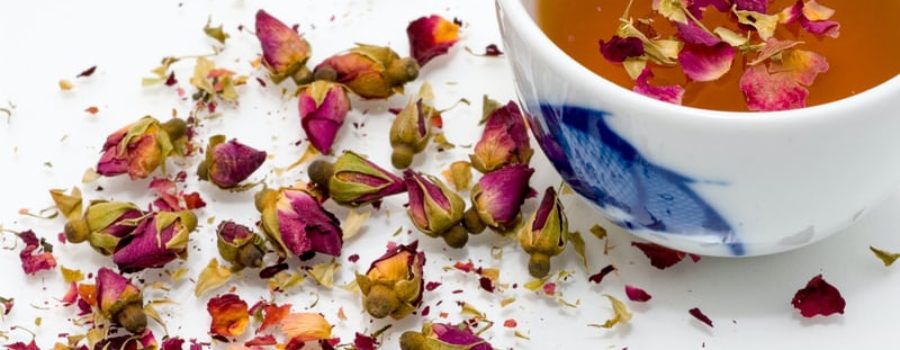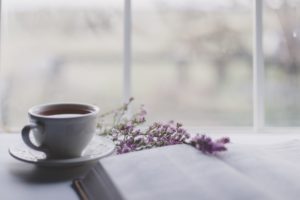This blog post was written by April Martin, LMT and Kathleen Martin, LOCC
The story of tea began somewhere around 2737 BC. The Chinese Emporer, Shen Nung, was sitting underneath the camellia sinensis tree with a cup of hot water in hand when a leaf fell into his cup. This is how tea was first discovered. Tea has been around for thousands of years and has been recognized as a form of medicine assisting to bring good health to the body. Origins of tea were recognized for medicinal properties first and secondarily as a pleasurable beverage.
In the beginning of recorded history there was evidence of natural medicine, healing teas and the use of plants as medicine. Some of the oldest records found on medicinal plants are from the Egyptian Ebers Papyrus, 1500 B.C. In India around 700 B.C. there are more that 300 documents medicinal plants that originated from the Charaka Samjita.
Long before there were any written records there were healers. The healers of primitive times were priest and priestesses, the shamans and witch doctors, the medicine men and women were believed to be able to commune with the Great Spirit of the cosmos. Herbs were used in healing rituals amongst Indigenous cultures. They discovered by trial and error which plants were suitable as food and valuable medicinal qualities. The healing plants were dried and stored for use as needed. Medicinal plants and herbs were used to help the wounded and seriously sick, but were administered along with incantations, frenzied dancing and loud banging of the drums. These activities were to attract the benevolent intervention of the Gods and drive away the negative spirits. The patients were at peace and rested well knowing that the healer had called forth the Gods on their behalf. The Ancient healers were treating both the mind and the body. They were the original holistic physicians.
Today, physicians are starting to study the ancient healing systems of both China (Traditional Chinese Medicine) and India (Ayurveda). This is a continued practice of highly refined form of natural medicine that is completely compatible to the human body. Both China and India are based on the strong foundations of healing teas to bring health to the mind and body.
Herbal science has now become medical science. Over 70 percent of today’s drugs are derived from natural substance. The public has mostly lost the old ways of medical teas and remedies. People are just now beginning to study the history of herbal medicine and what plants can do to heal. Many of these have been used for millennia in the ancient healing system.
For example, long before aspirin existed various parts of the willow were used as anti-inflammatory agents and relief from pain. Years ago, scientists confirmed that the salicin derived from the willow family relieves pain and reduces inflammation and lowers fever. The herbalists knew the properties of the willow and have used it ages before. And consider the opium poppy (Papaver somniferous) offers important pain-relieving analgesics and narcotics, including morphine, codeine and thebaine.
There are millions of species of plants on Mother Earth. Two thirds of all plant species flourish in the tropical rainforest and entire species are disappearing at alarming rates as civilization comes closer to the forest. Fifty thousand plants and animals are being lost each year. There are dedicated people working frantically to save specimens of threatened plants from disappearing rainforest. The National Cancer Institute reports 70 percent of the plants identified as useful in the Treatment of cancer are found only in the rainforest.
Fortunately, we still have a wide variety of effective natural medicinal herbs available to us, including many that have survived since ancient times. There are many ways to use nature’s medicines. No matter what method is employed, the idea is to release extract, and activate all the useful properties of the plant. This is accomplished through infusion. Infusion is just another name for tea. When you put a tea bag or loose leaf herbs in a strainer in a cup of hot water, you’re making an infusion. This is the easiest and most common way of preparing a healing tea. There are many benefits to drinking a cup of tea. It’s often easily accessible and cost effective. Herbal infusions (tea) often can address our digestive woes, sleep imbalances, effects of stress, anxiety and decreases inflammation to name of few. Including herbal medicine in your daily life will increase your overall health and wellbeing.
*As always, know your sources when sourcing herbs. Please, when possible, use organically and sustainably grown and harvested herbs. Anything I communicate is for educational and informational purposes only and not intended to diagnosis, treat, cure or prevent any illnesses. It is recommended to seek advice and suggestions from a trusted healthcare professional, especially if you’re taking any medications, are pregnant/nursing or have any medical conditions. You are ultimately responsible for your own health.



Leave a Reply
Your email is safe with us.